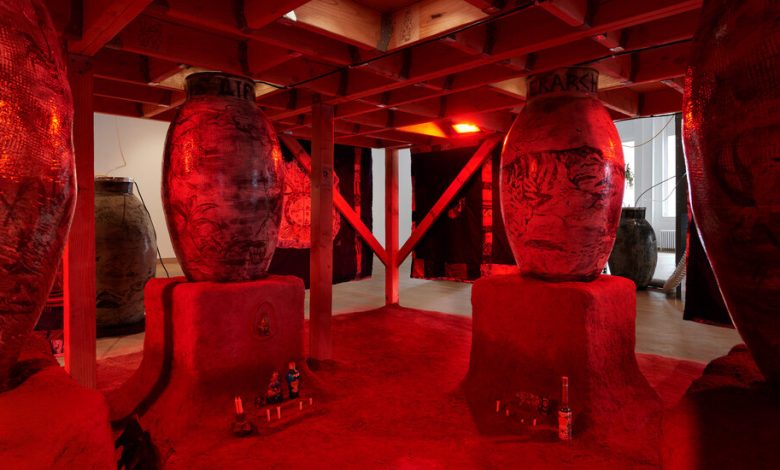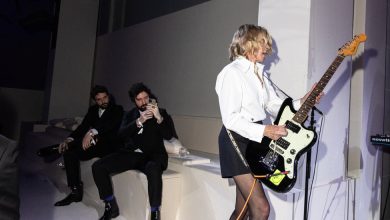When a Job Becomes a Literal Hell

If you peered through one of the microscopes at the artistCandice Lin’s installation “Lithium Sex Demons at the Factory,” on view at Canal Projects in downtown New York last fall, you would have seen a writhing horned creature, animated in psychedelic colors on a small video screen.One such screen was embedded in each of the six metal workbenches that lined the edges of the space; at the center of the room was a wooden platform, raised several feet off the ground — a surveillance tower from which visitors could assume the perspective of an employer presiding over the stations below. Lin, 45,was partially inspired by the Malaysian-born anthropologist Aihwa Ong’s research into accounts of demonic possession and paranormal activity among a group of women in rural Malaysia in the 1970s. The women had suffered lithium poisoning while working at battery factories and began to break into fits of destructive rage during their shifts. In Lin’s retelling, the workers are resurrected as demons, seething with chaotic desire.
Stories of exploited, vengeful workers are an established subgenre in art and pop culture. Think of movies like “Office Space” (1999), in which a trio of office drones, consistently humiliated and mistreated by their supervisors, concoct a scheme to rob their company, or “9 to 5” (1980), starring Dolly Parton, Jane Fonda and Lily Tomlin as secretaries who overthrow their misogynist boss. In the past few years, since the pandemic triggered one of the worst job crises in decades and as burnout rates reach record highs among Americans, many releaseshave depicted similarly debilitating workplace angst. The restaurant kitchen in FX’s series “The Bear,” which premiered in 2022, is a ticking time bomb of screaming, stove fires and oil burns. And in the French Canadian director Éric Gravel’s 2021 film, “Full Time,” a single mother’s life as the lead chambermaid of a luxury hotel in Paris unfolds with the intensity of a continuous heart attack. These stories are extreme yet familiar. (“The Bear,” for all its frenetic pacing, dips into full-blown surrealism only during interludes showing lead chef Carm’s dreams.) But in the year and a half since social-distancing orders were lifted, labor conditions for many workers have remained just as precarious, and a spate of recent projects seem to be asking, What happens after burnout? These stories portray workers who are not simply anxious and exhausted but violently combusting.
In the upcoming Romanian movie “Do Not Expect Too Much From the End of the World,” a film-production assistant named Angela zooms around Bucharest interviewing ex-factory workers who wereinjured on the job. Ironically, her own livelihood seems to be putting her in danger:She works 16-hour days and spends a good chunk of her shift driving up and down a narrow, single-laneroad that locals call “Death Highway.” (An extended montage shows the graves of the more than 600 people who have perished in crashes along this stretch). The director Radu Jude wrote Angela’s character with a real-life P.A. in mind: a 22-year-old who died after falling asleep at the wheel. Pushed to breaking point, Angela only finds reliable relief via the foul-mouthed tirades she films as her online alter ego, Bobita. If overwork depletes us, forcing us to abandon our personal lives, then, Jude seems to suggest, our last defense might be to build brand-new selves, ones that are too outrageous and furious to be denied.
But when self-degradation feels like a standard part of the job description, what becomes of the human bits we leave behind? Last summer, a retrospective at New York’s Whitney Museum dedicated to the artist Josh Kline, “Project for a New American Century,” seemed to align fortuitously with the concerns of the screenwriters and actors who were striking at the time. That movement pushed back, in part, against the unchecked use of A.I., which, the strikers argued, threatens to dehumanize the creative work force. Kline’s work has long explored the dystopian possibilities of technology: Series such as “Unemployment” (2016) and “Blue Collar” (2014-20) — both of which were featured in the Whitney show — use 3-D-printed sculptures toreckon with the punishing nature of labor and the displacement of workers by automation. In “Blue Collar,” shopping carts and a janitorial buggy are filled with plastic body parts and flesh-colored appliances, as well asboxes of brandedmerchandise and cleaning supplies, reminding viewers of the violence of equating people with commodities. In “Unemployment,” life-size sculptures of office workers curled up in the fetal position are wrapped in transparent plastic trash bags, gesturing at the disposability of human labor. Both series show in a “stark and unsettling way just how precarious certain jobs are,” says Christopher Y. Lew, the retrospective’s curator. “And the kinds of extremes people are willing to go to just to complete their work.” Kline’s collection of limbs are an eerie reminder of what’s at stake in the late-capitalist rat race: Collectively, we’re not so much addicted to work, he seems to say, as we are acutely aware that our jobs are required for our survival.




